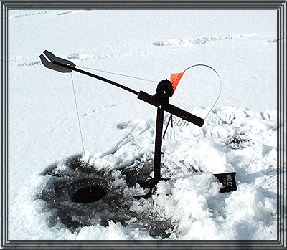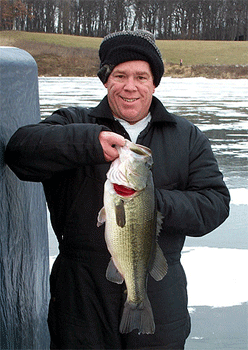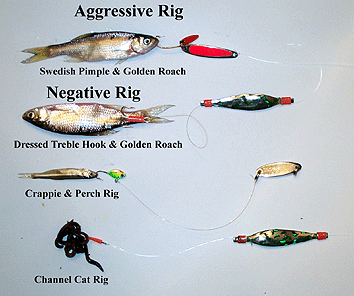

When we arrived on the ice it was brutal! Even with temps in the upper 20's we had a 15-25 mile an hour wind. Most guys would not even try to venture out on a day like this. I looked at Danny and just smiled and said PERFECT!
Today our plan was to run Wind Tip-ups for Pike and Bass on a slough next to Lake Wisconsin. We started drilling holes along a weed edge in 5 feet of water, spacing each tip-up about 20yds apart, taking time to tune each tip-up into the  wind. We set 3 up for heavy jigging action and 3 for light jigging. 3 tip-ups were rigged with large Swedish pimples in various colors tipped with large golden roaches the other 3 were rigged with attractors and dressed hooks.
wind. We set 3 up for heavy jigging action and 3 for light jigging. 3 tip-ups were rigged with large Swedish pimples in various colors tipped with large golden roaches the other 3 were rigged with attractors and dressed hooks.
After getting them all baited and tuned to our liking, we jumped into the warm tent and waited. The tip-ups looked like oil rigs pumping away in the wind. I was just starting to pour a cup of coffee when the first flag went off. Dan took off running as the spool on the tip-up was running off like a funny car in the 1/4-mile. A quick set of the hook and Dan was into our 1st pike of the day, which turned out to be a nice fat 32 incher. My turn was next about 5 minutes later when the farthest flag went off. I ran my butt off to find the spool not moving, I checked the bait and all was well. After setting it up again I started off back to the tent. I didn't get 10 yds away when it went off again, this time with another smoker. I slammed the hook home and was quickly into another nice pike. This went on for the next 5 hours with a nice mix of big pike and bass. The guys came out later in the day where running standard tip-ups, and only had 1 flag go off for 15 units. They even put flags ten feet away from ours in desperation trying to get fish, NOTHING. We ended up with a 2-man limit of northern and released 4 bass in the 3-4 pound class.
Wind tip-ups I think fell out of grace with most ice fisherman due to the lack of knowing how to rig them and how to tune them. We see maybe (1) wind tip-up out of 100 each of the last 4 winter seasons, even up north in tip-up territory they are not commonly used. In the past 4 seasons, they have produced more and bigger fish on almost every outing. Don't get me wrong, they are not magic and they do have their limitations, but once you have mastered them they are great tools to have in your spread. Wind tip-ups can do something we humans canít do, jig non-stop all day long, hour after hour! Let's dive in and go over most of the basic's you will need to know to enjoy these great fishing catching machines.
Wind Tip-up Design:  Unlike regular tip-ups, wind tip-ups are made to stand on the ice with just the line being in the hole. Wind tip-ups have a swing arm that has a metal plate in front that grabs the wind. The swing arm also holds the line spool along with the flag. You have 2 springs that control how much the main arm can pump in the wind. The light spring is good for light lures and baits along with a light wind. The heavy spring is good for strong winds and heaver baits. The spring arm attaches to the main support that is adjustable at the base to angle the swing arm to catch the amount of wind you want for that day.
Unlike regular tip-ups, wind tip-ups are made to stand on the ice with just the line being in the hole. Wind tip-ups have a swing arm that has a metal plate in front that grabs the wind. The swing arm also holds the line spool along with the flag. You have 2 springs that control how much the main arm can pump in the wind. The light spring is good for light lures and baits along with a light wind. The heavy spring is good for strong winds and heaver baits. The spring arm attaches to the main support that is adjustable at the base to angle the swing arm to catch the amount of wind you want for that day.
Setup: If you look at Fig 1 you will see the adjustment screws. The screw that holds the line spool is your tension control this determines how fast line will pay out when a fish takes your bait. You want it to turn easily but not to freely to backlash if a fish takes off in a hurry. The spring attaches to a metal adjustment bar, the more you pull down on the spring the higher the arm will raise into the wind. The bottom adjustment screw will allow you to tilt the tip-up allowing even more wind control. The metal plate that the line flows through can be bent for even more wind catching in light winds. Play around with this and you will soon see you can fine-tune it for most conditions.
Lures:  Looking at Fig 2 and Fig 3 gives you a great starting point when picking out lures to run on your Tip-ups. If I had to pick 2 lures for gamefish, it would be a Swedish pimple or a ball jig. Both can be fished in all kinds of wind and both fish well with both active and negative fish.
Looking at Fig 2 and Fig 3 gives you a great starting point when picking out lures to run on your Tip-ups. If I had to pick 2 lures for gamefish, it would be a Swedish pimple or a ball jig. Both can be fished in all kinds of wind and both fish well with both active and negative fish.
Line:  Dacron line, Fireline, and line made for tip-ups all work fine, and 15-20 pound test works well here in Illinois. Use a 2-foot leader of 6-10 pound test of a good quality mono that will hold up well attached to your main line. When spooling your line on to the spool make sure your reel it on towards you! If you donít when a fish takes your bait it will suck your flag in, not releasing it like it should. This will result with your tip-up pounding into the hole.
Dacron line, Fireline, and line made for tip-ups all work fine, and 15-20 pound test works well here in Illinois. Use a 2-foot leader of 6-10 pound test of a good quality mono that will hold up well attached to your main line. When spooling your line on to the spool make sure your reel it on towards you! If you donít when a fish takes your bait it will suck your flag in, not releasing it like it should. This will result with your tip-up pounding into the hole.
Rigs: The photo of rigs covers all the rigs you will need while running your tip-ups. Straight lures are great when fish are aggressive, when fish are slow try using an attractor and dressed single or treble hook. I use Golden roaches in the biggest size I can get here in Illinois but up in Wisconsin I use Red Tail Chubs. I hook my baits through the lips when fish aggressive fish and tail hook them when negative or small suckers.
Baits: Golden Roaches, Fatheads, Shiners, Red tail Chubs and Red worms all have their place and time. Here in Illinois Golden Roaches and Shiner Minnows work very well for Pike, Bass, and large panfish. Red Worms are great for Channel cats and Nightcrawlers will catch trout in the harbors.

Tuning them on the ice: Drill your hole and leave some ice chips close by to anchor the base. Lower your bait until it hits the bottom. With the wind plate just above the water, reel up the slack so your bait is just off the bottom. Next push the flag into the spool to hold it in place. Position the wind tip-up into the wind and anchor the base with ice chips. Now pull the spring adjustment down so the wind arm starts to go up. Stand back and see how much jigging action you are getting. Adjust the spring and or lower angle adjustment until you are happy with the amount of jigging the tip-up is doing. When running a spread, adjust them at different actions, let the fish tell you what they want.
Limitations: Because of their design, wind tip-ups work best when temps are 20 or above. If you use them in colder weather you will need to keep the holes clean so the line will not freeze to the skim ice, keeping it from jigging. If that happens, you will come back only to find your bait ripped of the hook.
Give these types of tip-ups a try and Iím sure you will be hooked just like the 100ís of fish we catch every season on this misunderstood fishing tool.
Enjoy!
Mike A.